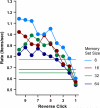Hybrid foraging search: Searching for multiple instances of multiple types of target
- PMID: 26731644
- PMCID: PMC4754784
- DOI: 10.1016/j.visres.2015.12.006
Hybrid foraging search: Searching for multiple instances of multiple types of target
Abstract
This paper introduces the "hybrid foraging" paradigm. In typical visual search tasks, observers search for one instance of one target among distractors. In hybrid search, observers search through visual displays for one instance of any of several types of target held in memory. In foraging search, observers collect multiple instances of a single target type from visual displays. Combining these paradigms, in hybrid foraging tasks observers search visual displays for multiple instances of any of several types of target (as might be the case in searching the kitchen for dinner ingredients or an X-ray for different pathologies). In the present experiment, observers held 8-64 target objects in memory. They viewed displays of 60-105 randomly moving photographs of objects and used the computer mouse to collect multiple targets before choosing to move to the next display. Rather than selecting at random among available targets, observers tended to collect items in runs of one target type. Reaction time (RT) data indicate searching again for the same item is more efficient than searching for any other targets, held in memory. Observers were trying to maximize collection rate. As a result, and consistent with optimal foraging theory, they tended to leave 25-33% of targets uncollected when moving to the next screen/patch. The pattern of RTs shows that while observers were collecting a target item, they had already begun searching memory and the visual display for additional targets, making the hybrid foraging task a useful way to investigate the interaction of visual and memory search.
Keywords: Attention; Human search; Hybrid foraging; Hybrid search; Multiple targets; Visual search.
Copyright © 2015 Elsevier Ltd. All rights reserved.
Figures











Similar articles
-
Hybrid foraging search in younger and older age.Psychol Aging. 2019 Sep;34(6):805-820. doi: 10.1037/pag0000387. Epub 2019 Aug 15. Psychol Aging. 2019. PMID: 31414857 Free PMC article.
-
Hybrid value foraging: How the value of targets shapes human foraging behavior.Atten Percept Psychophys. 2018 Apr;80(3):609-621. doi: 10.3758/s13414-017-1471-x. Atten Percept Psychophys. 2018. PMID: 29270798
-
You look familiar, but I don't care: Lure rejection in hybrid visual and memory search is not based on familiarity.J Exp Psychol Hum Percept Perform. 2015 Dec;41(6):1576-87. doi: 10.1037/xhp0000096. Epub 2015 Jul 20. J Exp Psychol Hum Percept Perform. 2015. PMID: 26191615 Free PMC article.
-
The role of memory for visual search in scenes.Ann N Y Acad Sci. 2015 Mar;1339(1):72-81. doi: 10.1111/nyas.12667. Epub 2015 Feb 12. Ann N Y Acad Sci. 2015. PMID: 25684693 Free PMC article. Review.
-
Foraging behavior in visual search: A review of theoretical and mathematical models in humans and animals.Psychol Res. 2022 Mar;86(2):331-349. doi: 10.1007/s00426-021-01499-1. Epub 2021 Mar 21. Psychol Res. 2022. PMID: 33745028 Review.
Cited by
-
Implicitly and explicitly encoded features can guide attention in free viewing.J Vis. 2020 Jun 3;20(6):8. doi: 10.1167/jov.20.6.8. J Vis. 2020. PMID: 32531062 Free PMC article.
-
Risky hybrid foraging: The impact of risk, reward value, and prevalence on foraging behavior in hybrid visual search.J Exp Psychol Gen. 2024 Nov 14:10.1037/xge0001652. doi: 10.1037/xge0001652. Online ahead of print. J Exp Psychol Gen. 2024. PMID: 39541518
-
Priming effects in inefficient visual search: Real, but transient.Atten Percept Psychophys. 2022 Jul;84(5):1417-1431. doi: 10.3758/s13414-022-02503-5. Epub 2022 May 16. Atten Percept Psychophys. 2022. PMID: 35578002 Free PMC article.
-
Hybrid foraging search in younger and older age.Psychol Aging. 2019 Sep;34(6):805-820. doi: 10.1037/pag0000387. Epub 2019 Aug 15. Psychol Aging. 2019. PMID: 31414857 Free PMC article.
-
Using Eye Movements to Understand how Security Screeners Search for Threats in X-Ray Baggage.Vision (Basel). 2019 Jun 4;3(2):24. doi: 10.3390/vision3020024. Vision (Basel). 2019. PMID: 31735825 Free PMC article. Review.
References
-
- Arrington CM, Logan GD. The cost of a voluntary task switch. Psychological Science. 2004;15(9):610–615. http://dx.doi.org/10.1111/j.0956-7976.2004.00728.x. - DOI - PubMed
-
- Bond AB, Kamil AC. Visual predators select for crypticity and polymorphism in virtual prey. Nature. 2002;415(6872):609–613. - PubMed
-
- Cain MS, Vul E, Clark K, Mitroff SR. A Bayesian optimal foraging model of human visual search. Psychological Science. 2012;23:1047–1054. http://dx.doi.org/10.1177/0956797612440460. - DOI - PubMed
Publication types
MeSH terms
Grants and funding
LinkOut - more resources
Full Text Sources
Other Literature Sources
Research Materials

